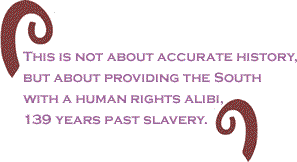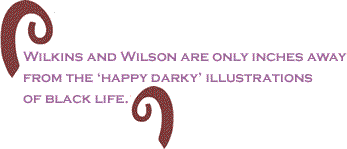
|
|||||||||||||||||||||
 |
|||||||||||||||||||||
 |
|||||||||||||||||||||
 |
This article originally appeared on Africana.com. These days it’s getting harder to tell whether history is repeating itself or if human beings are just becoming more cliché. This was underscored last week when it came to light that Cary Christian Academy, a private school in North Carolina, was using the deceptively titled pamphlet “Southern Slavery, As It Was” in their curriculum. Among the more notable claims presented by authors Doug Wilson and Stephen Wilkins were neglected virtues like: “Many Southern blacks supported the South because of long established bonds of affection and trust that had been forged over generations with their white masters and friends." Or this gem: “There has never been a multi-racial society which has existed with such mutual intimacy and harmony in the history of the world." Listen close and you can almost hear the banjoes
strumming in the background. Officials at the school defended
the 43-page tract, arguing that they want to present students
with “both sides” of the Civil War story and that students also
read speeches by Abraham Lincoln. Ironically enough, the “both
sides” approach does not include the perspectives of the actual
black people who lived through slavery. A random selection
from John Blassingame’s Slave
Testimony yields this first-person dissenting opinion:
“[The mistress] took her in the morning, before sunrise, into
a room and had all the doors
Any few pages in your college-worn copy of The
Narrative of the Life of Frederick Douglass would put
the lie to Wilson and Wilkins claim that “Slave life was to them
a life of plenty, of simple pleasures, of food, clothes, and good
medical care." And one wonders where Harriet Tubman, bludgeoned
so badly as a child that she suffered from bouts of narcolepsy
for the rest of her life, fits into this backdrop of happy plantation
This is not about accurate history, but about providing the South with a human rights alibi, 139 years past slavery. It is about a vast capacity for willful self-delusion, the need to provide self-absolution for the sins of the so-deemed Peculiar Institution. Thus you see the kind of historical hairsplitting of “Southern Slavery, As It Was”: Slavery was wrong…but not as bad you might think. And sadly enough, it’s not only in the far precincts
of the Christian right that we hear these kinds of weak rationales.
The Southern Alibi tradition rests upon the now–outmoded
All these defenses – whether presented at academic conferences or passed out to adolescents in private academies of the far-right, are invested in viewing slavery as a labor system operated by rational, managerial white folk – the plantation equivalents of Jack Welch or Lee Iacocca. But in order for these theories to work, they also have to overlook the concomitant cruelties of sexual exploitation of enslaved black women, which was common enough to be a defining characteristic of the institution. Again, even a commonplace text like Harriet Jacobs’ Incidents in the Life of a Slave Girl or Deborah White’s Aren’t I a Woman would illustrate the fact that rape was an intricate part of enslavement in this country. Nor can these depictions of slavery-lite explain away the dissolution of families for profit and the inhuman breeding of blacks to produce additional chattel for the slave owners. It would be easy to dismiss these disputes as the arid exercises of the History Forensics Society were the implications for our everyday lives not so serious. Truth told, Wilkins and Wilson are only inches away from the “happy darky” illustrations of black life and if this is “Southern Slavery, As It Was” then they would be hard-pressed to explain the literal hundred of slave revolts, attempted revolts, poisonings and fires that defined the South between the Revolutionary and Civil Wars. In airbrushing the brutality of slavery, we make it possible to ignore the tremendous power that race had – and continues to have – in shaping this society. To cut to the quick, until we are willing to grapple with slavery as it was, we will remain incapable of dealing with America as it is. William Jelani Cobb is an assistant professor of history at Spelman College and editor of The Essential Harold Cruse. He can be reached at [email protected]. Visit his website at www.jelanicobb.com. |
| December 23 2004 Issue 119 |
|||||||||
|
|||||||||
|
|
|||||||||
| Printer Friendly Version | |||||||||
 |
|||||||||
 |
|||||||||
 |
|||||||||
| |
|||||||||
| |
|||||||||



























